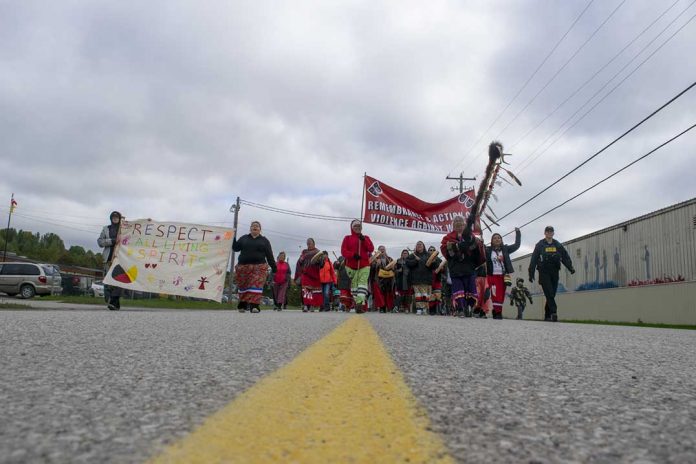By mid-1990s, victims start to share their stories publicly
EDITOR’S NOTE: The following story contains information about sexual abuse that took place in Wiikwemkoong during the mid-to-late 20th century. This information may be disturbing to those who have suffered from sexual abuse. Support is available 24/7 through the First Nations and Inuit Hope for Wellness Help Line at 1-855-242-3310 or the Manitoulin Family Resources crisis line at 1-800-465-6788.
WIIKWEMKOONG – When The Expositor began reporting in the 1990s on the news of Father George Epoch’s abuses as well as the associated lawsuits taking place at the time, more victims found the courage to reconcile with what had happened to them and stepped forward to share their stories. A meeting in late August 1996 at Rainbow Lodge in Whitefish River First Nation offered a chance for survivors to meet, discuss the lingering impacts of these abuses and see that they were not alone in their strife.
Although much of the attention in this case has been paid to Father Epoch, a man who has been labeled as one of the worst sexual abusers in Canadian history, the lawsuits from the ‘90s extended to Brother Norman Hinton as well. The current lawsuit also names a Brother O’Meare.
Around the same time as the August 1996 healing meeting at Rainbow Lodge, a woman who was dubbed ‘Cecilia Peltier’ contacted the Manitoulin Recorder because she had heard stories two months earlier of similar abuse that her husband experienced while he attended the residential school in Spanish. ‘Cecilia Peltier’ was not the woman’s real name; rather, it was a pseudonym given to her by author Jane Story to allow her privacy in the wake of sharing her husband’s experiences on a subject with such serious implications.
On Sunday, December 6, 1992, the National Film Board of Canada premiered the first part of a two-part docudrama titled ‘The Boys of St. Vincent’ on CBC Television. It explored the story of an orphanage in Newfoundland that was run by Catholic Brothers where hundreds of young residents were abused by staff members.
The following night, the second part aired to offer a perspective from 15 years after the incidents. The airings were part of a Supreme Court of Canada case on whether CBC should have been allowed to feature the special at that time, because there happened to be a trial underway involving a similar sex abuse scandal in Montreal. Airing the docudrama may have prejudiced the jury. The subsequent ruling of Dagenais v. CBC went on to shape the laws surrounding court-ordered publication bans in Canada to this day.
One of Mr. Peltier’s sons brought home the video and he had to leave the room shortly after it started. Mr. Peltier had previously told his wife that similar things had happened in the Spanish residential school when the first news of the St. Vincent crimes broke, but he never said that he was a victim himself. After the special aired he opened up to her about what he had experienced at the hands of Father Epoch as a student.
“The assaults began when he was only 10, just shortly after arriving at the school in the late 1940s. Assigned to work in the kitchen, there were many opportunities for the priest to get him alone,” wrote Ms. Story in a September 4, 1996 article in the Manitoulin Recorder. “The abuse started with a pat on the back and then the bum. But it soon escalated to oral sex and sodomy.”
Mr. Peltier had never revealed any of this to his wife during 33 years of marriage. He further described how Father Epoch, who was at that point still an initiate in the church, would make nightly visits to the boys’ dormitory, something that was described as “a game of roulette.”
“It was just devastating to go to bed at night and not know if it is your time. From 11 years old, he went to bed wishing he would never wake up,” Ms. Peltier was quoted as saying.
Mr. Peltier tried many times to run away but was always stopped and had to face punishment. The priests said God would never forgive him if he shared his story, but he told the Father Superior and his mother anyway. Neither believed his tale.
Mr. Peltier left school at age 16 and later joined the army, but found its structure too authoritarian and he had to leave. He took up a series of low-income work positions and began drinking. He struggled to trust others for the rest of his life.
Although his wife went to church regularly, Mr. Peltier could not bear to enter the building, let alone look at the priest. After he shared what had happened, she too had doubts about her faith.
Mr. Peltier experienced headaches and impotency in his life and eventually disclosed his past to his doctor in Little Current.
His wife said the impacts on communities are wide-reaching and extensive.
“While Ms. Peltier says her husband never abused their children, she knows that many men who were abused, in turn are abusing their own children; the perpetrator is often a victim,” wrote Ms. Story. “There is hardly one family in her community or in many other native communities who has been left unscathed by this abuse.”
In the modern day, some abuse survivors are turning to the internet to share their stories. Sylvia MacEachern runs a blog at TheInquiry.ca simply called ‘Sylvia’s Site,’ in which she has collected names of church figures who have been accused and convicted of sexual abuse.
The comments on the site are littered with posts by victims who have expressed their gratitude to those advocating on their behalf. The Expositor connected with a victim who suffered at the hands of Father Epoch and will be sharing their story in subsequent coverage.
•••
The Expositor will be following the new developments in this case as more information becomes available, as well as sharing stories and past records that bring context to the crimes of Father George Epoch, Brother Norman Hinton and Brother O’Meare from their time in Wiikwemkoong.





